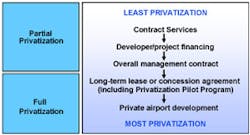SAN DIEGO — As airlines continue to adjust assets with demand in a struggling economic environment, airports meet to discuss the effects of an ever-evolving aviation industry at the F. Russell Hoyt National Airports Conference (NAC) held here in September. Hot-button issues include
airline economics, privatization, airport funding, and security. On the issue of FAA reauthorization, attendees and speakers alike hold little hope for bill passage before year’s end, meaning everything on that front may have to start over with a new Congress.
Hosted each fall by the American Association of Airport Executives (AAAE), the NAC is an executive-level compact networking venue for exchanging ideas and sharing information. With no shortage of challenges facing the aviation industry, one positive expressed was the apparent, yet sluggish recovery of the global airline business.
Comments Air Transport Association VP of policy Patty Higginbotham on the state of the airline industry, “ ... It’s still not good, but news is better this year.”
She relates that the industry has laid-off some 160,000 employees and has drastically cut capacity, and while carriers will make money this year, the industry is still very much feeling the effects of the recession. The future also depends a lot on where jet fuel prices go, she adds, stating that oil has gone up some 39 percent since this time last year.
“We are hopeful,” she says, yet with 10 percent unemployment in the States and many travelers having less disposable income, “ ... It’s an uphill battle,” she adds.
Cleveland director of airports Ricky Smith says airlines are beginning to find the ‘sweet spot’ in matching capacity with demand, and it’s starting to pay off in Cleveland. “Airlines are thinking more progressively,” says Smith, by better aligning assets with demand.
Fresh off negotiations with a merging Continental, Smith says the airport has been preparing for consolidation; a strong working relationship with the carrier has helped to solidify its commitment to the region (UnitedContinental has agreed to sustain its Cleveland hub for at least another five years).
“The health of the U.S. airline industry is obviously getting better,” relates AAAE chair Jim Bennett, former director of the Metropolitan Washington Airports Authority and now president of the Abu Dhabi Airports Company.
FAA’s Catherine M. ‘Kate’ Lang agrees, stating, “We think the carriers have seen the light.” The consequences of airline right-sizing is beginning to correct the market, she adds, “Yet the slope for growth is pretty sluggish.”
A new normal
Remarks Eno Transportation Foundation president Stephen D. Van Beek, “Aviation is a low-margin and highly cyclical industry, which if anything has become more dynamic in the last decade.
“Given the strong correlation between Gross National Product growth and demand for transportation services, the slower recovery has resulted in lower than expected traffic levels and lower trust fund revenues to support U.S. Department of Transportation infrastructure programs.”
Van Beek says 2009 was a tough year for all airports, even for large hubs. In addition he comments, “Passenger growth is outpacing capacity, returning a degree of pricing power to air carriers.”
With 2010 showing marginal improvements in traffic and capacity, Van Beek says things have definitely gotten better this year, when considering all airports as a whole.
After a disastrous ‘08 and ‘09 for airlines, 2010 is shaping up to be a better year, explains Van Beek. “Should economic growth come anywhere near historic trends, many airlines are poised for sustained profitability.
“With the reduction of airlines’ fixed costs and improved operations, new revenues are more likely to be translated into profits.”
With flights, passenger traffic, and yields down over the past decade, the uncommitted balance in the Airport and Airway Trust Fund is at a very low level, providing few resources for long-term FAA priorities, explains Van Beek.
“Even with the passage of the American Recovery and Reinvestment Act, there is a declining long-term trend of taxpayer support for aviation programs,” he relates.
A passenger facility charge (PFC) increase is critical, says Van Beek. Had PFCs been indexed to inflation, he adds that the ceiling would be worth $8.14 today. Currently, the value of the $4.50 PFC is worth $2.52 in today’s dollars.
It is also critical, he says, that Congress extend the Alternative Minimum Tax (AMT) holiday and the Build American Bonds, stating, “Airport bonds continue to be a vital tool to leverage resources and to finance projects, particularly in this time of low interest rates.
Van Beek offers three issues that should shape airport policy priorities:
1) Seek new sources of public and private capital.
Federal efforts with TIGER grants (intermodal discretionary), innovative finance (infrastructure bank, TIFIA), and incentivizing privatization provide options to the traditional and shrinking trust fund sources.
2) Prioritize transportation system investments that include aviation.
Move away from modal focus to system-based solutions, including the aligning and integrating of air and surface networks; implementing NextGen; and promoting efficient use of congested facilities through operations, incentives, and pricing.
3) Tackle climate change and promote sustainability.
International and national concern over environmental issues and energy use require more focus on reducing emissions and saving fuel.
Recommendations Van Beek offers for transportation providers include:
• Policy Context is Dynamic. Pressures to restore the economy, deal with the nation’s debt and deficit issues, and shift policy priorities will make this a fluid policy environment for the next several years. Be responsive to the change.
• Promote Sustainability. Analyze the agency’s carbon footprint and energy use. Prioritize the highest return, lowest cost solutions and move to instill sustainability throughout the organization.
• Define Projects for the Policy Context. What contributions will particular projects make to the new set of national priorities?
• Practice Inclusive Planning on a Metropolitan and Regional Basis. Most regions, reinforced by federal policy, do not effectively tie public and private, passenger and freight, and modal planning together. To make system improvements, better integration of planning is required.
• Help Educate Policymakers and Shape Authorizations: There are many misconceptions about transportation; the industry needs to define the benefits and help redesign all transportation programs.
Airport Privatization
Privatization is not a panacea, relates Sheri Ernico, director at Leigh/Fisher, a management consulting firm.
“Private airports are not necessarily the most profitable or efficient,” she adds. Many airports serve broader community interests, and some private airports lack incentives to serve broader constituencies. “Commercial performance is more dependent on factors such as infrastructure, tax rates, percent of international passengers, etc.,” explains Ernico.
Apart from that, there are also many barriers to airport privatization in the U.S., from access to cheap tax-exempt debt to restrictions on revenue diversion to collective bargaining agreements and public sector unions, says Ernico. This makes the U.S. airport model unique.
When considering airport privatization, Ernico says there are many resources airports should evaluate, including:
- Lessons learned from worldwide airport privatization;
- Lessons learned from privatization in non-airport transportation modes;
- Legal regulatory framework;
- Domestic policy context (AIP, PFC, tax-exempt bonds, municipal budget deficits, etc.);
- Stakeholder interests and concerns;
- Case studies; and
- Decision tree matrix and evaluation checklist.
FAA compliance division’s Kevin Willis explains that privatization is a local decision “ ... and our role is to review that decision. We look at privatization as a management tool,” adding that one size does not fit all when it comes to airport privatization.
Explains Willis, “Privatization is not something that you create and then walk away from. What happens is a relationship change. You change from managing a workforce to managing a contract.
“You have to map out how you plan to bring an airport through the initial implementation ... transparency and public outreach is important.”
TSA: Checkpoint Technology
“I think the future for now is AIT (advanced imaging technology) for people-screening,” says Robert Kane, assistant administrator for security technology at TSA. “We are seeing a very high-acceptance rate [among the public] despite the press otherwise.”
Kane says TSA would like to consolidate the footprint of the checkpoint. “We would like to see the walk-through metal detector go away as a side-by-side capability,” he adds. “Throughput-wise, we have to make sure the technology can get to where we need on the throughput before we start pulling the metal detectors out.”
Remarks TSA Kane, “People are comparing AIT to the walk-through metal detector and that’s the wrong comparison.
“What we are seeing is the limiting factor continues to be the x-ray screening of accessible property, and the impact of the way people are traveling with more carry-ons is significantly impacting the throughput at checkpoints.
About the Author

